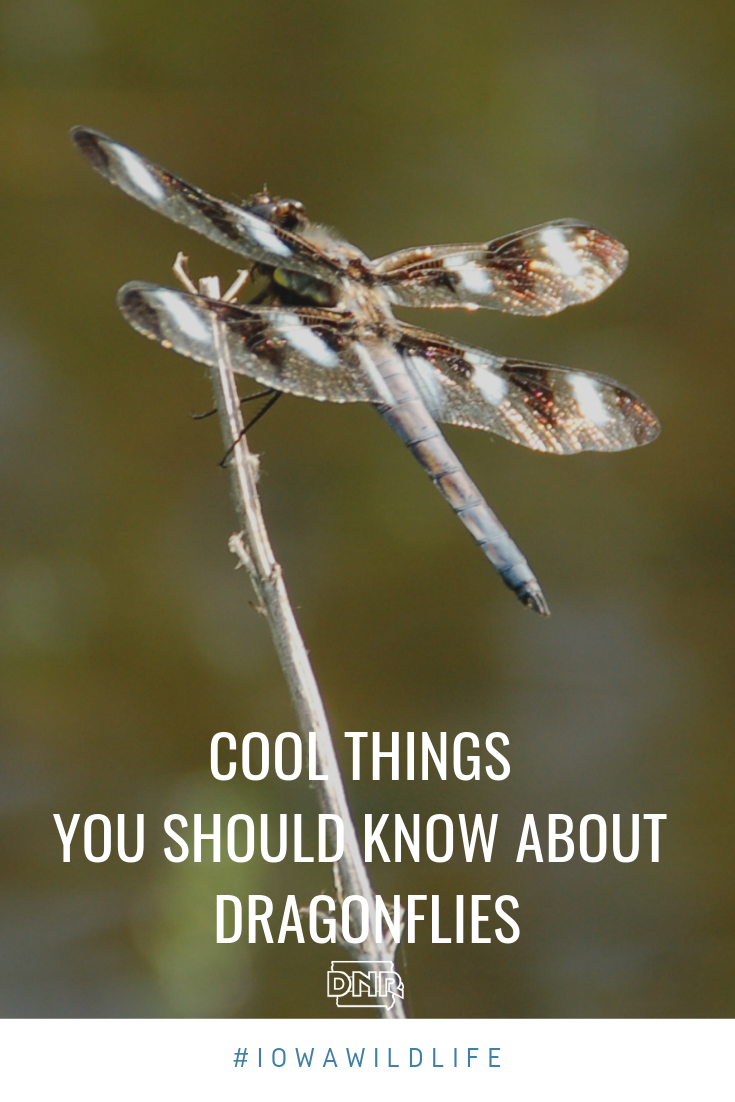Dragonflies are fascinating bugs you can spot right here in Iowa. Check out these cool things you might not know about these insects:
Water-dwelling young
Nymphs, or dragonfly larvae, live underwater as wingless insects. This stage of the dragonfly life cycle can last up to four years in some species.
During the nymph stage, dragonflies move quickly in the water by forcing water out of their hind ends, similar to the way Jet Skis move.
 While living in the water, nymphs undergo a series of growing stages, or instars. During each instar, the nymphs grow larger until they’re ready to become an adult. At the right temperature and with the perfect weather, the nymphs crawl out of the water, usually onto a plant stem or leaf. Then, they shed their skin and emerge into a young adult. If you look along the water’s edge, you might spot the left behind skin, called exuvia.
While living in the water, nymphs undergo a series of growing stages, or instars. During each instar, the nymphs grow larger until they’re ready to become an adult. At the right temperature and with the perfect weather, the nymphs crawl out of the water, usually onto a plant stem or leaf. Then, they shed their skin and emerge into a young adult. If you look along the water’s edge, you might spot the left behind skin, called exuvia.
Incredible flyers
Dragonflies hunt other flying insects, so agility is key. To aid in this, dragonflies can move and rotate each of their four wings independently. Thanks to this unique ability, these insects can fly backwards, up and down. They can turn on a dime and can hover, all contributing to their great flying abilities.
Fierce predators
Both nymphs and adult dragonflies are top predators in the insect world. Larger nymphs will eat tadpoles and minnows. Nymphs have a modified lower jaw they can extend using hydrostatic pressure to capture prey as it swims past.
As adults, these insects capture up to 95 percent of the prey they hunt. The adults will chase down their prey and ambush it from behind.
Unique sun protection
Dragonflies can’t use sunscreen, but they do have a method to protect themselves from the sun — obelisking. An adult dragonfly will perch with its abdomen held vertically, exposing a minimal amount of their body to the sun’s rays, to avoid overheating.
Swarming dragonflies
Large groups of these bugs will congregate to hunt in places with abundant insects. Different species of dragonflies swarm together, working to eat their fill. Some species migrate, and they will create swarms to move together as well. To find out more about the different dragonfly species, you can look at the Iowa Dragonflies website.
These swarms last for a very short amount of time, so there’s not a lot known about this behavior. If you’re lucky enough to spot a swarm of dragonflies, you can report it to help with researching and understanding how these insects operate.
Mating wheel
The heart-shaped mating wheel makes dragonfly mating easily identifiable. Usually around the water’s edge, a male dragonfly will grab a female by the back of her neck with claspers at the end of his abdomen, creating the mating wheel. These structures fit into species-specific grooves.
Once the pair has formed their wheel, they will fly together in tandem until the female lifts her abdomen up to the male’s accessory organ. The process may take a minute or two or several hours, depending on the species.
After mating occurs, the pair may separate and fly away, or the territorial male may follow the female to guard her from other males while she lays eggs in the water. After laying the eggs, dragonflies will mate a few more times before dying of old age - in only a month or two.